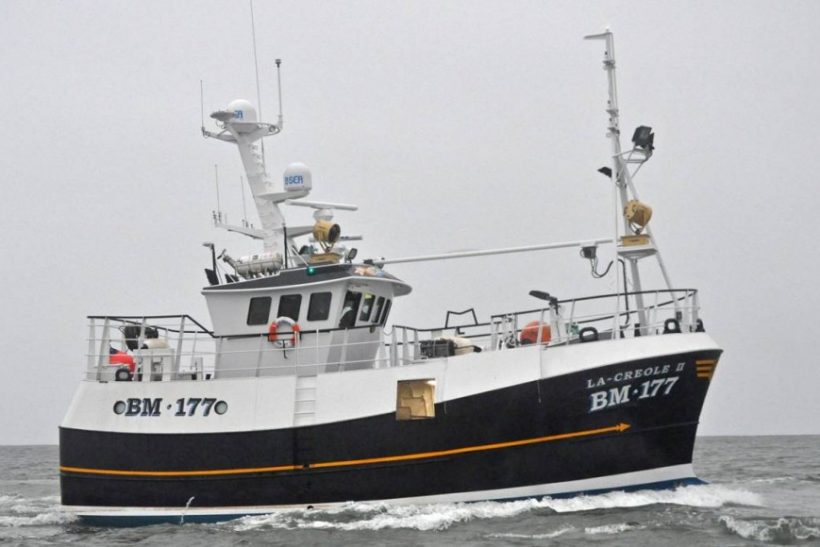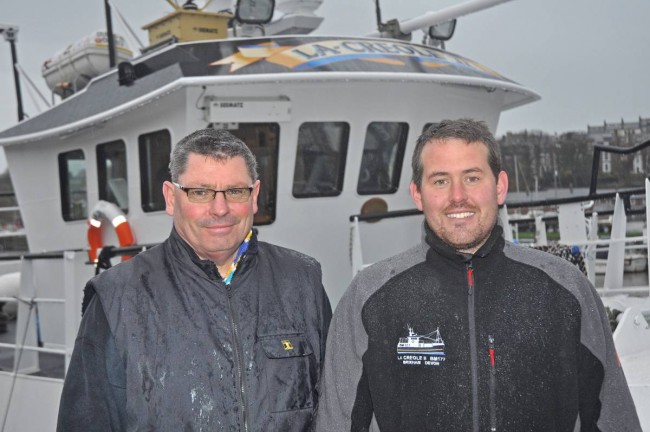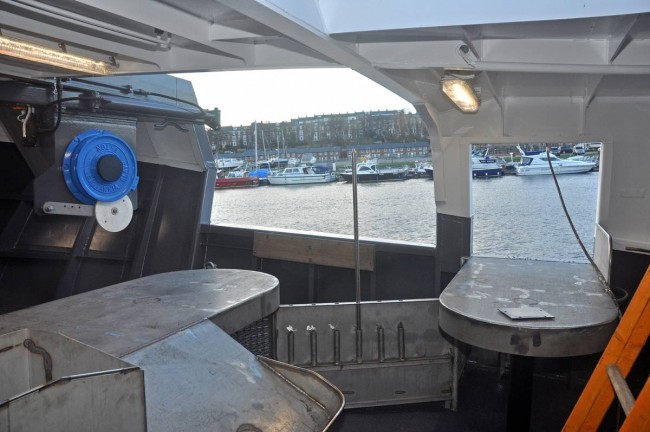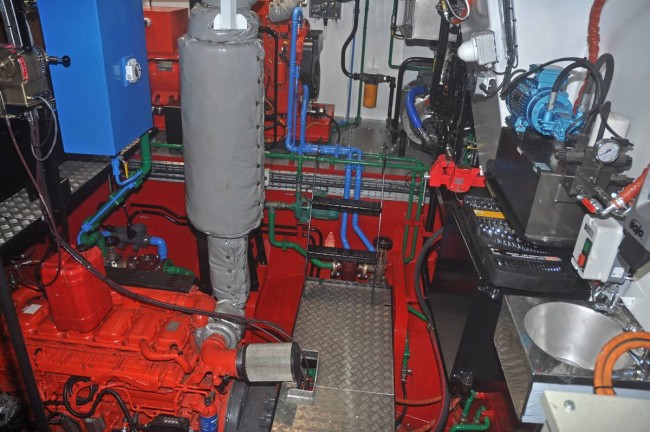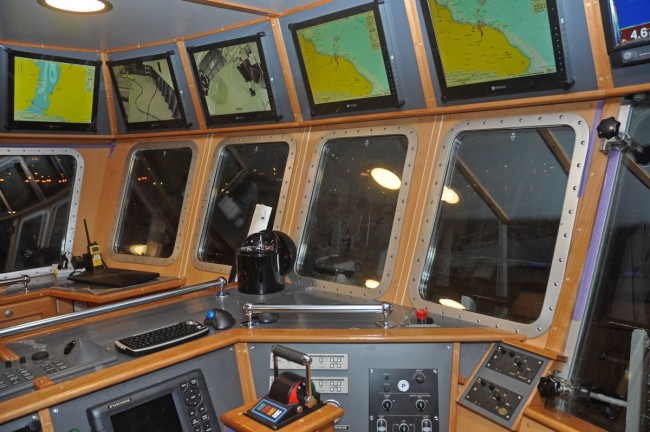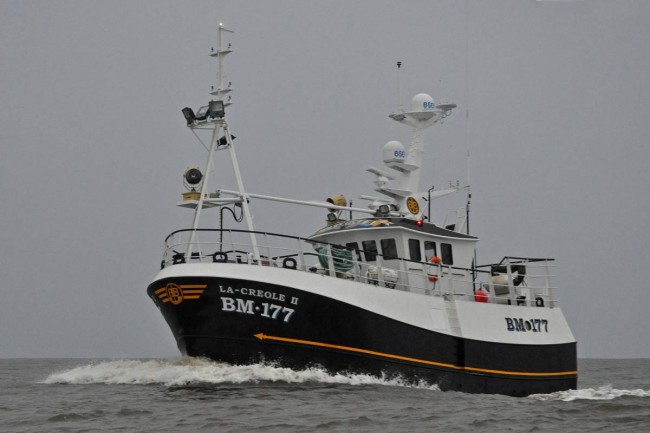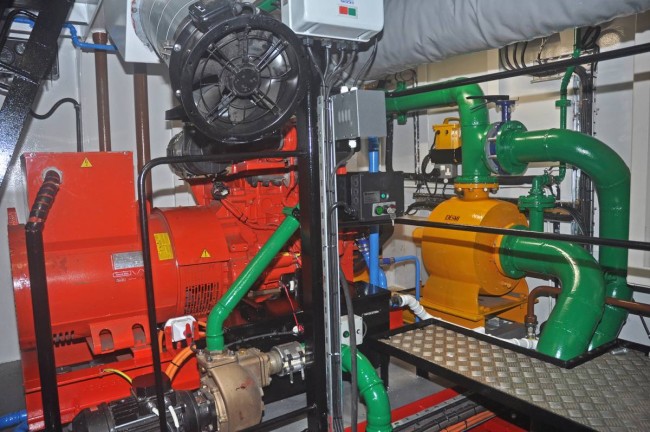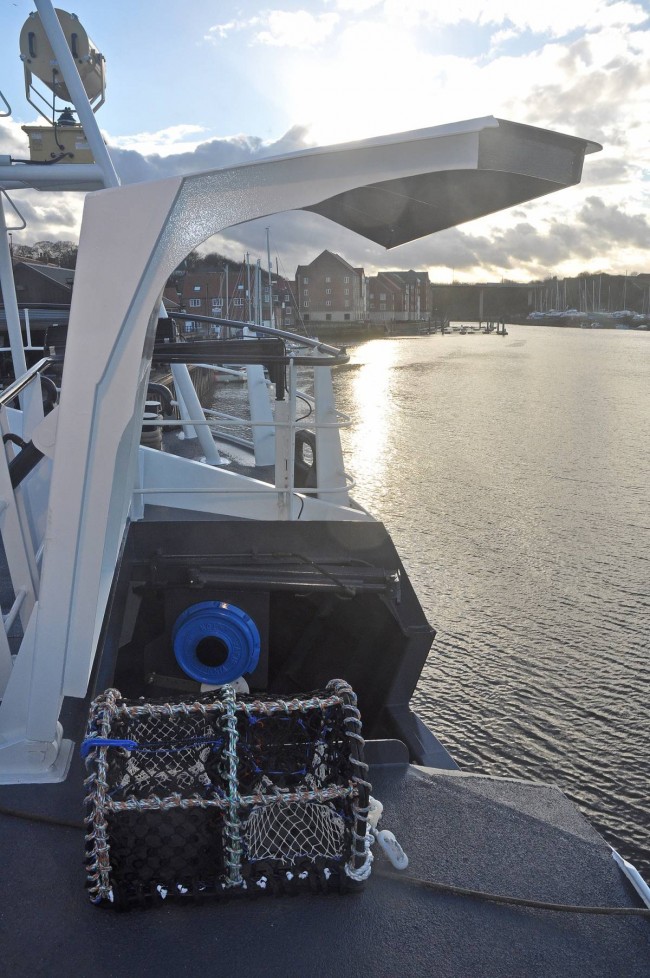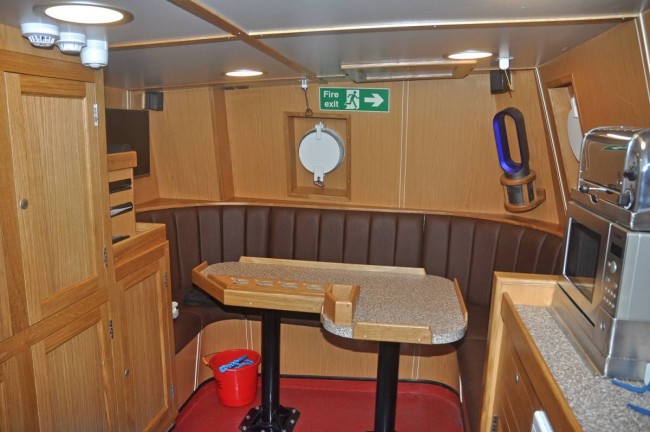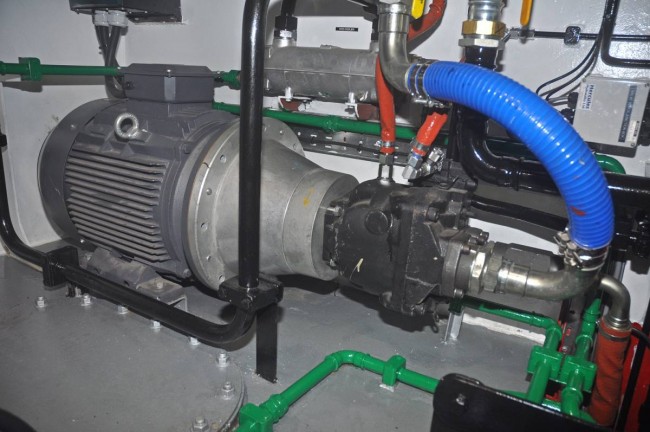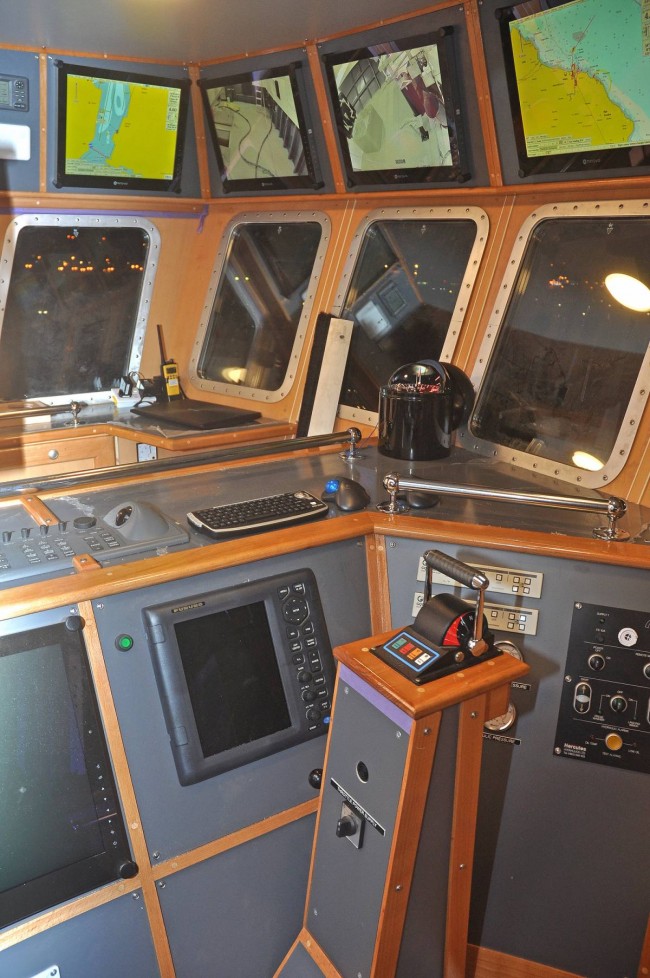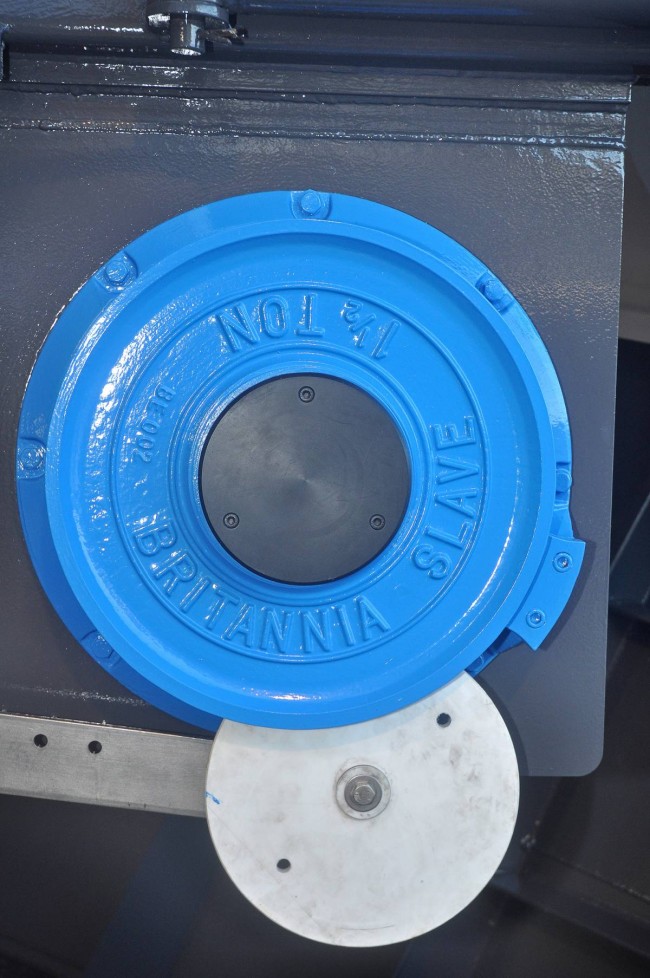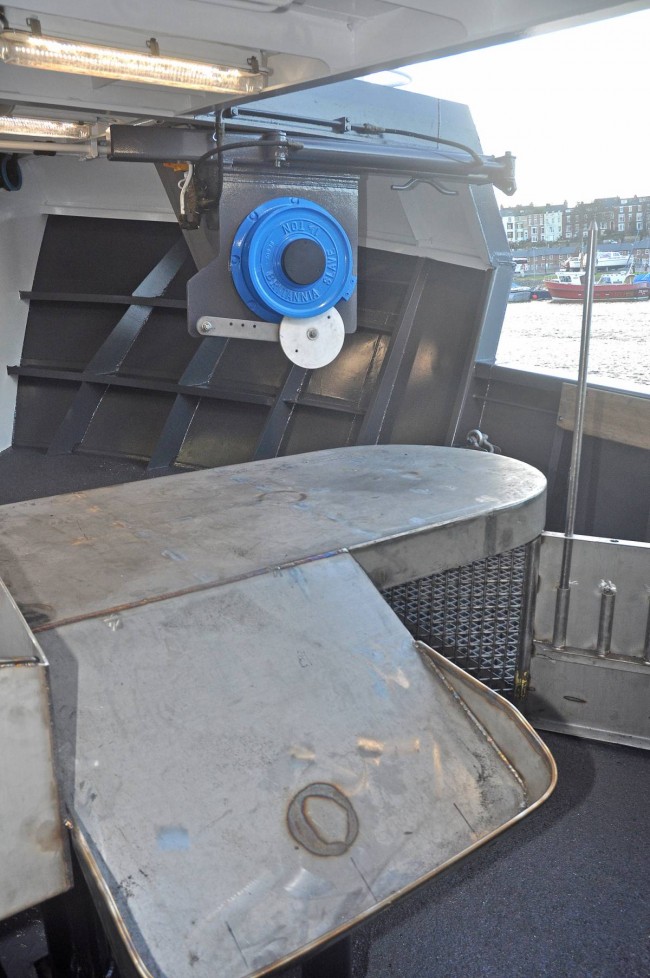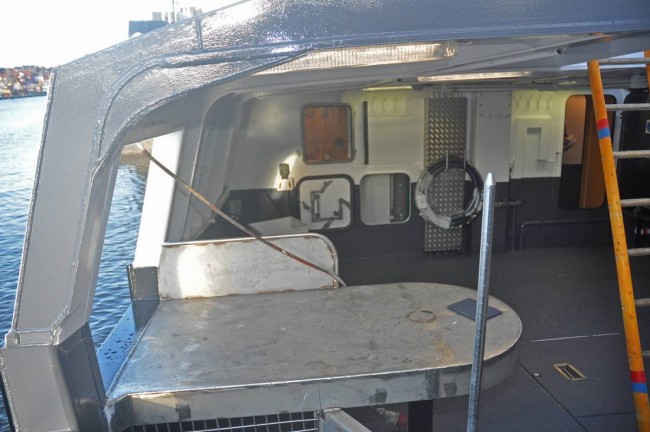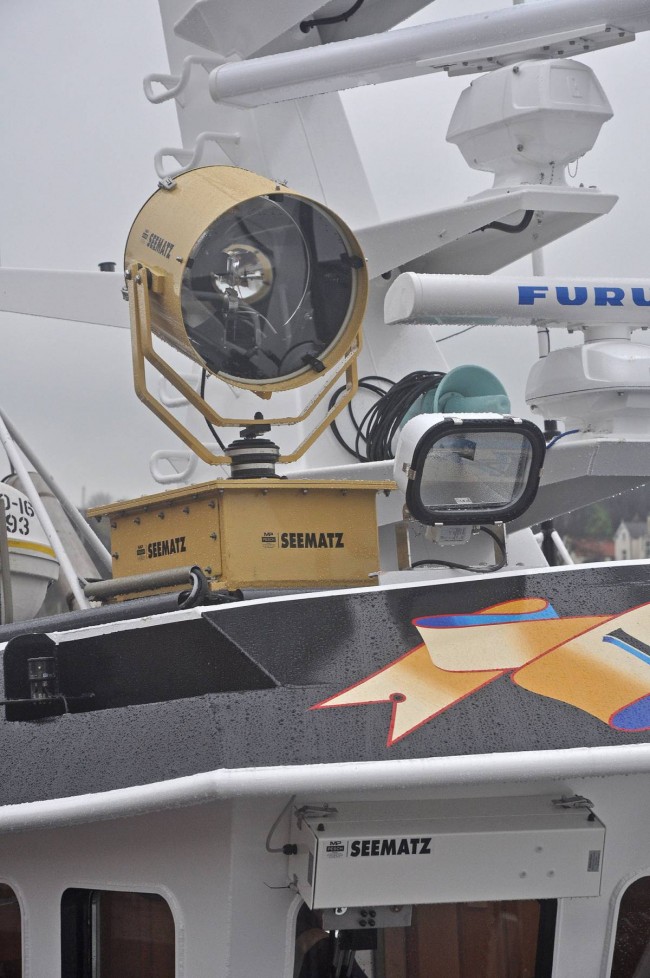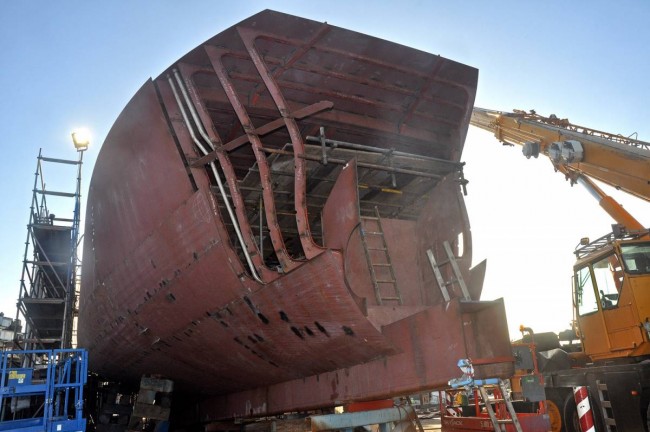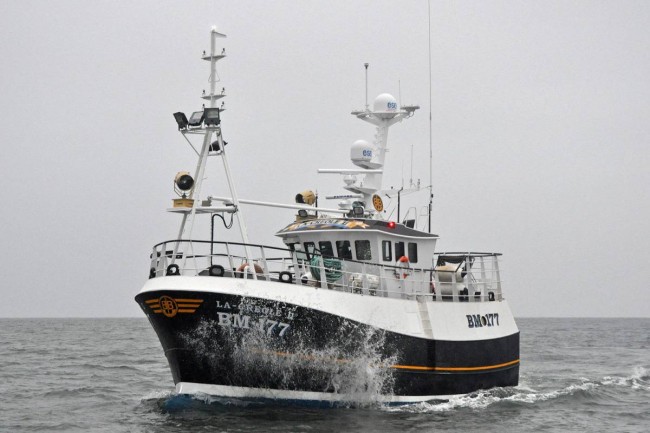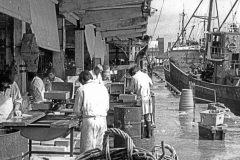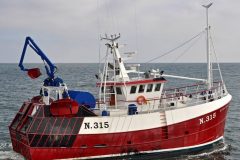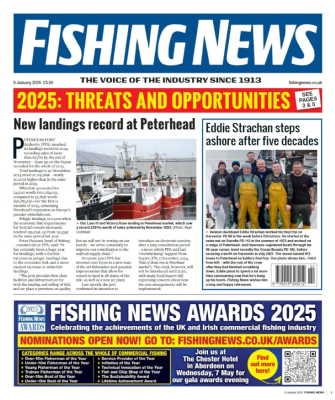South Devon crabbing skippers Paul Brown and Nick Bright, of Brown and Bright Shellfish Ltd, took delivery of their new 14.95m vivier-crabber La Creole II BM 177 earlier this month, reports David Linkie.
La Creole II was built by Parkol Marine Engineering at Whitby, almost exactly 10 years after Parkol completed the similar-sized Ebonnié BM 176 for Brixham skipper Nick Bright. Since 2006, Ebonnié has been skippered by Paul Brown, who, by coming from Dartmouth, one of the main bastions of crabbing in South-West England, has a lifetime’s experience of the shellfish sector.
Skippering Ebonnié for such a long period of time, during which the vivier-vessel has worked in a number of different locations, including the English Channel, The Irish and North Seas and to the North of Scotland when fishing out of Scrabster, clearly provided Paul Brown with countless opportunities to evaluate the boat’s working characteristics and seakeeping qualities.
This meant that when Paul Brown realised his lifetime’s ambition to build a new boat, by establishing Brown and Bright Shellfish Ltd in partnership with Nick Bright, he was in the strong position of knowing exactly what he wanted from the new boat, based on his experience of Ebonnié.
That La Creole II and Ebonnié share broadly-similar hull designs and internal layouts is testimony to the consistently successful fishing performance Ebonnié has returned since 2005, which ultimately led to Nick Bright and Paul Brown showing their total satisfaction in this product and the associated customer loyalty, by placing a near repeat order for La Creole II with Parkol Marine Engineering in October 2014.
A repeat order for an almost identical second vivier-crabber is also the best possible indication of total confidence in the companies involved, as well as healthy shellfish stocks and consistent market demand for brown crab and lobsters.
Insured by Sunderland Marine, La Creole II is initially expected to fish in the North Sea before landing into the nearest convenient port, including Denmark and Holland. Catches from La Creole II (and Ebonnié) will be handled by Macduff Shellfish Ltd, with whom Nick Bright and Paul Brown have a close and mutually beneficial working relationship.
Shortly before La Creole II left Whitby for Lowestoft, to take on board new crab gear supplied by Gael Force and Tyson, skipper Paul Brown said: “Ebonnié has consistently met our requirements for a purpose-designed versatile boat enabling us to land top-quality catches of brown crab, lobster and whelks with consistently high levels of work efficiency and crew safety. Therefore we are confident that in La Creole II, we have a boat that will enable us to complete on a similarly strong footing in years to come.
“All the main players involved in the design, build and fit-out of La Creole II have contributed as expected to the delivery of a vessel that enables us to face the future with confidence.”
The fully-shelterdecked La Creole II looks what she is – a medium-sized stylish boat fitted-out to combine maximum operational reliability with working simplicity. By working five- to six-day trips there is little doubt that skipper Paul Brown and his five crewmen will soon be fishing in some heavy weather, which the boat seems more than capable of taking in her stride.
Designed by Ian Paton of SC McAllister, the main dimensions of La Creole II are: LOA 14.95m, registered length 14.15m, beam 5.9m, depth moulded 3.50m and GT 41.12. Of double chine form, the steel hull incorporates a semi-bulbous bow, raked soft-nose stem and transom stern, the corners of which are well-rounded to enhance manoeuvrability, both in harbour and keeping station to the gear while hauling.
Below main deck level, the hull is arranged from forward into a 50m3 dry-hold incorporating two freezer bait stores, 30t vivier hold, engineroom, and six-berth accommodation cabin aft.
As the full-width deck casing is arranged across the stern under the full-length shelter, 2/3 of the vivier-vessel’s main deck is clear of any obstructions, providing the maximum amount of deck space possible for working and storing static gear. Interestingly, the carefully planned gear-handling arrangements, developed in line with the owners’ well-established crew and vessel safety management systems, do not include any form of self-shooting system.
Rather, a dedicated shooting table, together with a toggle system, is positioned aft of the hauling position at the starboard shoulder. Served by a smaller shooting hatch in the side of the shelterdeck, this arrangement is similar to the one that Paul Brown has worked for some years now on Ebonnié.
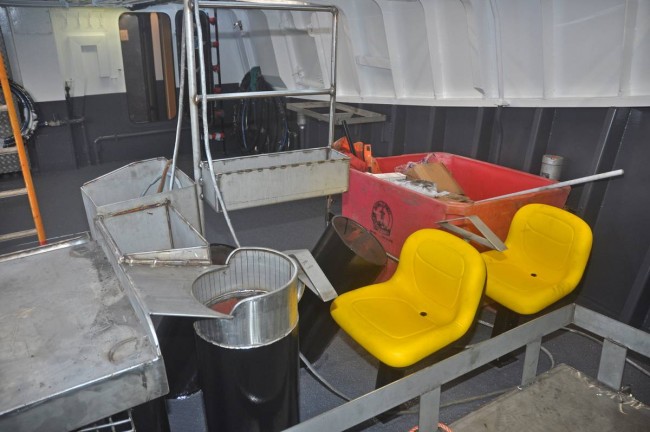
Twin nicking bars and seats are positioned alongside dedicated delivery chutes leading to the 30t vivier hold.
La Creole II uses a 1.5t Britannia slave hauler, manufactured by Britannia Engineering of Brixham for hauling her gear. Controlled electronically from the wheelhouse, the 17in-diameter hauler is mounted on a hanging box from the underside of the shelterdeck, and positioned inboard of the hydraulically-operated telescopic hauling arm that is fitted with a traditional open-sided hanging block.
Raised and lowered by two hydraulic rams, the large hauling hatch provides skipper Paul Brown with a commanding view at all times from the NorSap helmsmen’s chair located near the forward starboard corner of the wheelhouse. When fishing in poor weather, the hatch can be lowered to provide increased protection on deck, with pots then being shot off a gunwale table through a small opening.
The stainless steel receiving table, which incorporates an inclined secure clearing/rebaiting platform at the inboard end, is positioned aft of the slave hauler and well inboard of the gunwale rail. This arrangement enables the back rope to flake down onto the deck, while allowing two crewmen to work on the fore and aft sides of the table. As pots come aboard, they are immediately detoggled off the back rope, with the spinners placed on one of six shooting needles.
Selected brown crab are placed into the newly-developed Mustang Engineering’s crab bins. The bins are securely held in place by a stainless steel deck rack, from which two crewmen, working at the nicking positions towards the portside, pick them for cutting. Cut brown crabs are delivered to the 30t vivier-hold by two delivery chutes conveniently located alongside the nicking bars and seats.
When emptying pots, undersized and rejected shellfish are returned to the seabed from the clearing table via an adjacent large-diameter vertical pipe that leads straight down through the vessel’s hull via the dry-hold.
Rebaited pots are placed across the full width of the main deck forward of the accommodation casing, from where they are quickly placed on the shooting table for re-toggling when the gear is shot away again.
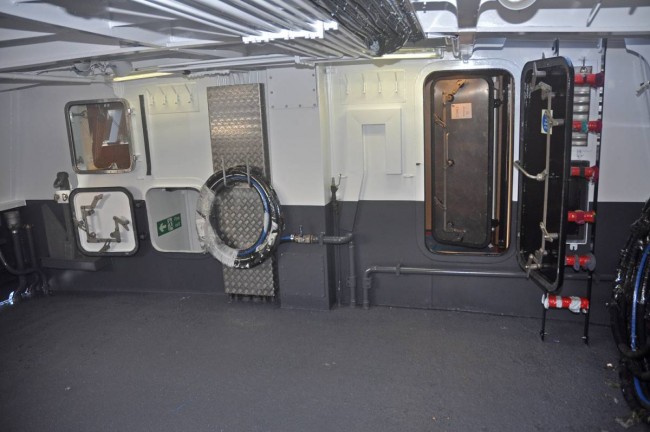
A full-width accommodation casing is arranged at the aft end of the expansive working deck amidships.
Clearly skipper Paul Brown has put a lot of thought and forward planning into the fine-tuning of the working arrangements on La Creole II, in order to achieve optimum levels of efficiency and crew safety.
Forward of the working area on the main deck, a raised coaming gives access to a full-depth dry hold that provides an impressive 50m. of storage space. Well-insulated and GRP-lined bait storage rooms, capable of holding 4t of frozen fish, are arranged on top of the vivier-hold either side of the central vivier trunking. The copper-piped freezing system, fitted on the underside of the deckhead, was installed by the Cornwall-based refrigeration specialist Alex Pino, who runs Alpino Services.
Enough bait for each day will be placed in a stainless steel deck bin located forward on the portside, eliminating the need for the crew to keep returning to the hold for bait when fishing.
Seawater in the 30t vivier hold is renewed every 12 minutes by one of two 5in Desmi electrically-driven 415V pumps. One of the vivier pumps is located at the aft side of the vivier-hold in the engineroom, while the second lies forward in the dry-hold.
La Creole II is powered by a Scania DI13 071 six-cylinder main engine. Parkol Marine Engineering installed a similar unit in Ebonnié earlier this year, when the vessel was re-engined at Whitby. Supplied by Scania UK, the propulsion unit delivers 294kW @ 1800rpm via a Twin Disc MG 5114 gearbox with a reduction ratio of 4.86:1to a 1600mm-diameter 4-blade propeller. This combination of centreline machinery enabled the crabber to record an average top speed of 9.3 knots on trials off Whitby.
The crabber’s hydraulic system is driven off a gearbox PTO. The Britannia pot-hauler can also be operated by a second hydraulic pump driven by a 37kW electrical motor.
Auxiliary power comes from two Iveco NA55M2A engines supplied by Mike Rankin of Brixham Marine Services. Developing 73kW @1500rpm, the turbo-charged auxiliary engines each drive 62.5kVa 415/3/50 generators. Two Victon Energy 100amp inverters provide 24V DC supplies to the three sets of batteries fitted.
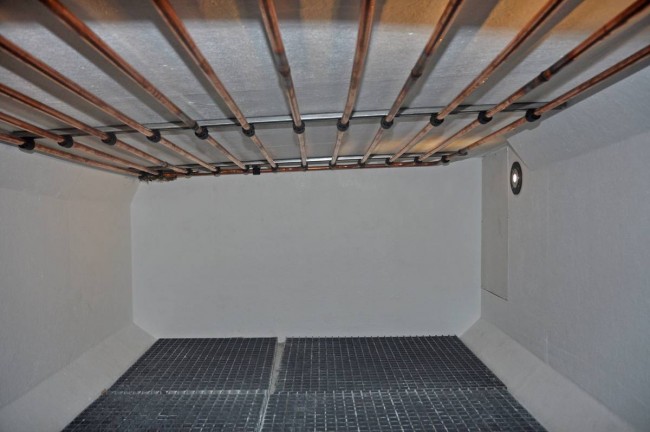
Alpino Services fitted the freezing systems in the 2t bait storerooms fitted on either side of the vivier trunking.
A 1t landing winch is hydraulically driven by either the gearbox PTO or electric motor.
The engineroom on La Creole II is neatly laid-out, diminishing the array of machinery and pipework fitted unobtrusively in it, while ensuring good service access to all items. The auxiliary engines are mounted on top of two 4,250-litre wing fuel tanks, and 4,500 litres of freshwater are carried in two tanks aft of the vivier trunkway and in the forward hold.
A watertight access door positioned to port of the vessel’s centreline gives access off the working deck amidships to the full-width deck casing arranged across the transom.
The internal passageway leads initially to a deck gear compartment on the portside and the main engineroom access to starboard. A single-berth skipper’s cabin is positioned along the starboard side of the hull, forward of the adjacent mess-deck. A well-equipped galley is arranged either side of the centreline, while a large shower and WC compartment is situated on the port quarter.
Six berths and generous locker storage provision are arranged in the main accommodation cabin down the aft stair, either side of the compartment housing the UK Marine steering gear.
Finished to a high level using light-coloured natural oak, all the internal accommodation areas are warmed by electric convection heaters.
Gael Force
La Creole II fishes exclusively with 26in D-section double soft-eyed crab pots manufactured at Stornoway by Gael Force Ltd.
Fitted with bait bags, the 26in pots are worked at 15-fathom spacings, in strings of 100 on 15.5mm backropes.
When La Creole II is routinely overturning the gear, the pots will usually be stored three or four-high across the full width of the main deck. However, when moving to new ground, the large deck area available, together with the toggle system, will enable 4-5 sets of gear to be moved at the same time.
After berthing at Lowestoft 15 hours after departing Whitby, La Creole II took aboard 400 new Gael Force 26in pots before starting to fish in the North Sea.
Skipper Paul Brown said: “During 10 years of crabbing on Ebonnié, in our opinion the standard 26in pot, manufactured and rigged totally in-house by Gael Force, is best suited to our requirements, both in terms of catching efficiency and durability, and therefore overall economic performance.”
Personalised wheelhouse
La Creole II’s aluminium wheelhouse provides skipper Paul Brown with a commanding view of hauling operations from the NorSap helmsman’s chair mounted on a sliding deck track in the forward starboard corner, within easy reach of the electronic controls for the slave hauler, joystick steering and engine controls.
Supplied by Peter Methven of Nor Sap UK, the backrest incorporates an embroidered version of the Brown & Bright Shellfish logo, to give a distinctive personal touch to an impressively-arranged wheelhouse.
While most of the electronic equipment is located in a U-shaped console around the skipper’s chair, six 19in Neovo displays are flush-mounted overhead across the full width of the wheelhouse.
Woodsons of Aberdeen supplied most of the electronic equipment, which was installed and commissioned by Stuart Laird and Graham Greig. Plymouth Marine Electronics supplied the Furuno FAR2117BB/XN 20 and Furuno MI 945 radars.
Vessel positioning data is supplied by two Furuno SC50 GPS compasses and a Furuno GP32 GPS receiver, displayed on two Olex 3D dual-screen seabed mapping systems. In addition to the usual AIS/ARPA interfaces, the plotters display ground discrimination from the input provided by a Hondex HE-1500di dual-frequency (50/200KhZ) colour sounder.
A Simrad AP-50 autopilot is also fitted.
Communications equipment includes a Sailor 6310 GMDSS MF/HF RT, two sailor VHFs, Esea60 Internet communications and E Catch electronic logbook systems.
Woodsons also installed a comprehensive CCTV, utilising four cameras and a 4-way switcher.
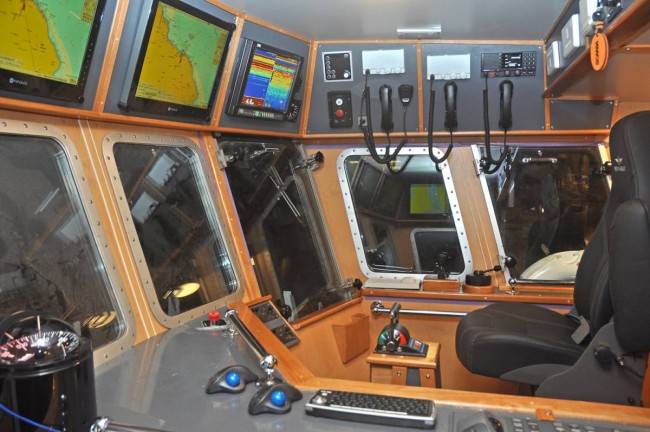
Woodsons of Aberdeen installed and commissioned the electronic equipment fitted in the well-equipped wheelhouse of La Creole II.
Seematz equipment enhance visibility
When fishing in poor weather and darkness, skipper Paul Brown will benefit from the optimum levels of visibility provided by Seematz equipment, for which Britannia Engineering are UK agents.
Two electronically-controlled Seematz 463mm-diameter 2000W searchlights are mounted on the foremast and the wheelhouse roof, to assist with locating dahn buoys when La Creole II is fishing overnight.
A Seematz wiper unit is also fitted to the deep window at the forward starboard corner of the wheelhouse overlooking hauling activities, in order to keep it clear of spray and rain at all times.
Manufactured in Germany, Seematz searchlights are widely used by a wide range of fishing and other commercial vessels. Giving ‘total daylight’ in excess of 300m, Seematz searchlights have become increasingly popular with potting skippers.
The Seematz range of searchlights is suitable for 24V, 110V, 240V or 415V electrical supply, and includes models between 250W-2000W and 175mm-580mm diameter.
French-built predecessor
La Creole II is named after her French-built predecessor, which Nick Bright operated for 25 years before the 13m wooden-hulled vivier-crabber was de-registered and sold for conversion into a house boat to facilitate the new build.
Of oak on oak construction, La Creole was built by the Stipon brothers’ yard in Le Fret Brittany in 1967 when, highly unusually, the boat featured three vivier-tanks holding up to 5t of crab.
After several changes of ownership in France, the boat moved to Guernsey in 1986 as Elley Roma, before Peter Merrien restored her original name of La Creole GU 54.
The following year, Nick Prust took La Creole to Brixham for use as a mid-channel crabber.
Eighteen months later, La Creole was bought by Nick Bright at the start of a 25-year association with the boat, during which time she was extensively refurbished.
Vessel Safety Management System
Safety and efficiency of working practise have been the two main drivers behind Paul Brown and Nick Bright’s operational ethos.
Nick explained: “We all know there is a cost per kilo caught, whether that is crab, lobster or whelk. Our focus is to constantly fine-tune the manner in which we operate, to generate the maximum return from the minimum costs without compromise to safety or the environment.
“Working Ebonnié so far from her home port has forced us to develop a comprehensive vessel inventory and parts to boat system, controlled by our stores manager and agent Tony Uil in Holland.
“Over the past 18 months we have developed this base system into a fully-integrated Vessel Safety Management System. This system includes crew and vessel certification, together with a planned maintenance programme and full Health and Safety compliance, including a customised and detailed risk assessment.”
During the last two MCA surveys/Inspections it has been noted by Paul and Nick Bright that things are on the change, in terms of vessel HSE. Accordingly, the owners are keen to be at the forefront of any HSE/Safety Management System developments.
Tyson’s Ships Riggers
Tyson’s of Grimsby supplied all the new backropes and tailings La Creole II is now using.
This extensive package of Tyson’s Eurosteel ropes, which includes 15.5mm leaded and 13.5mm unleaded, highlights the degree with which Paul Brown and Nick Bright have been working in close liaison with the company for some time now.
Sales Manager Jonathan Tyson said: “Tyson’s congratulates Nick Bright, Paul Brown and the team for their hard work and endeavour in creating such an impressive vessel as La Creole II BM 177.
“They know that, given the investment in a new vessel such as La Creole II, quality is paramount. Having the very best gear on board is crucial; this is why they have chosen Tyson’s Eurosteel ropes, the early feedback on which has been excellent.
“Watching the development of La Creole II on Parkol’s website, to supplying hundreds of coils of product from stock down to Paul and Nick’s store manager Dean Tinsley in Paignton, and then to see the launch and trials of the new vessel, has been an exciting time for Tyson’s. We feel privileged to be a part of this growing relationship and look forward to it growing even more. We wish skipper Paul Brown, together with the crew of La Creole II and the team ashore, all the best and a prosperous future.”
Versatile 27m Shetland whitefish vessel next for Parkol Marine Engineering
Having delivered La Creole II four months after completed the 26m whitefish trawler Guardian Angell LK 272, Parkol Marine Engineering continue to make good progress with the construction of a 27m versatile whitefish vessel for another Shetland partnership
The new design of seiner/trawler is being built for Shetland skipper Arthur Polson, together with partners Edward Jamieson, John Montgomery and John Irvine of the Resilient Fishing Company Ltd, to replace the owners’ current 24m twin-rig trawler Resilient LK 195.
Designed by Ian Paton of SC McAllister & Co Ltd, and scheduled for delivery in the early summer of 2016, the new build features a round bilge hull with a registered length of 23.95m and 7.8m of beam.
A triple Mitsubishi engine package, including a S12R-MPTAW main engine (588kW @ 1400rpm) Finnoy G50 FKV 10.75:1 reduction gearbox, 2700mm-diameter Finnoy VP propeller and two Mitsubishi 6D16T auxiliary engines, will be installed on the new whitefish vessel.
Three J’s of Thyborøn have supplied a custom-designed deck machinery package, including two power reels from which seine-net ropes and trawl wires will be worked through a Scantrol Isym system when fly-shooting, and a Scantrol auto-trawl system when single-rig trawling. With a core pull rating of 20t and a capacity of 3900m of 40mm-diameter seine-rope, the power reels will be positioned forward on the main deck. The ropes/wires will be spooled onto the power reels by electronically-controlled guiding, on gear incorporated into framework that will be fitted across the full width of the shelterdeck, aft of the power reels and forward of the vessel’s wheelhouse.
Two 2 x 8t split net drums will be arranged on the shelterdeck abaft the wheelhouse, together with a 14.5t unit on the quarter.
At the same time as further orders are in the pipeline, Parkol Marine Engineering is also scheduled to begin work on two major vessel re-engining and refurbishment contracts.
First up is Lockers Trawlers 26.5m pair-seiner Advance II WY 77. This project includes fitting a new Baudouin 12M26.2 main engine (428kW @ 1500rpm), Masson MM7400 8.653:1 reduction gearbox and a new 2300mm-diameter propeller, shaft, nozzle and streamlined nozzle.
A new Baudouin 6W126S auxiliary engine (260kW @1500rpm) will drive the main hydraulic system through a Technodrive clutch, in addition to a 75kVa Meccalte alternator. Similar electrical power will also be generated by a second new Baudouin 4W105S auxiliary engine of 73Kw @1500rpm.
The fishroom on Advance II will also be fully relined, at the same time as the engineroom and some general hull work is being carried out.
Gardenstown skipper George Hepburn’s Peterhead-based 19m twin-rig trawler Celestial Dawn BF 109 is scheduled to arrive at Whitby in mid-February, when work will commence to install a new Caterpillar C32 ACERT SCAC main engine (492KW @1800 rpm) to replace the existing Caterpillar 3412 propulsion unit.
Two new Mitsubishi S6S auxiliary engines (73kW @1500rpm), driving Meccalte alternators, will also be fitted on Celestial Dawn, together with a new customised 23oomm-diameter propeller and nozzle.
La Creole II BM 177
DETAILS
Owner: Brown and Bright Shellfish Ltd, Brixham, Devon
Designer: SC McAllister & Co Ltd
Boatyard: Parkol Marine Engineering, Whitby, Yorkshire
Agent: Macduff Shellfish Ltd, Mintlaw, Scotland
DIMENSIONS and CAPACITIES
Length overall: 14.95m; Length reg: 14.15m; Beam: 5.9m; Depth moulded: 3.5m; Draft: 3.6m; Tonnage: 41.12 tonnes gross; Fuel: 8,500 litres; Fresh water: 4,500 litres; Hydraulic oil: 600 litres; Vivier hold: 30 tonnes; Dry hold: 50m.
ENGINEROOM
Main engine: Scania DI 1307IM of 294kW @ 1800rpm driving through a Twin Disc MG 5114 4.861 reduction gearbox to a 1600mm-diameter four-bladed propeller. Speed: 9.3 knots
Auxiliary engines: 2 x Iveco NA55M2A naturally-aspirated of 73kW @ 1500rpm driving 62.5kVa 415/3/50 generators, hydraulically-driven landing winch. 2 x 100-amp Victron Inverters
Bilge/deckwash pumps: 2 x Cleghorn Waring AM 50 pumps driven by 4kW 415/3/50 electric motors
DECK MACHINERY
Suppliers: Britannia Engineering, Brixham, Devon – 1.5t pot hauler; 1t landing winch
CATCH STORAGE
30t vivier-hold served by 2 x 5in Desmi S125 100 pump driven by 5.5kW 415/3/50 electric motor delivering 150t/hr with six changes of water per hour and standby Cleghorn Waring pump belt driven off fore end of main engine
ELECTRONICS
Supplier: Woodsons of Aberdeen and Plymouth Marine Services
Bottom sounding
Hondex HE-1500di dual-frequency (50/200kHz) colour sounder
Navigation
Furuno AFR2117 BB and Furuno MI 945 radars c/w ARPA and AIS; Furuno GP32 GPS receiver; 2 x Olex 3D dual-screen plotting systems and ARPA/AIS/ground discrimination input; Simrad AP50 autopilot; 2 x Furuno SC50 GPS compasses. (Displays via 6 x 19in Neovo TFT screens)
Communications
Sailor 6310 150W GMDSS MF/HF SSB RT; Sailor 6215 DSC AND Sailor 6210 VHFs; Entel 6409 portable VHF; Phontech 3100 5-way talkback system; 4-camera CCTV system with 4-way switcher, Esea60 Internet communications system; Furuno NX 300 Navtex; E Catch Electronic logbook system
FISHING GEAR
Rope suppliers: Tysons, Grimsby – 15.5mm-diameter Eurosteel backropes; Pot manufacturers: Gael Force 26in D-section double soft-eyed creels
ACCOMMODATION
1 single-berth skipper’s and 1 x 6-berth cabins
GENERAL
Engine controls: Kobelt; Insurance: Sunderland Marine; Lifesaving appliances: Ocean Safety Ltd, Plymouth and Servitech; Paint: International Ltd; Steering: UK Marine Wheelhouse seat: Nor Sap; Windows: Wigo Windows
There’ll be more new boat features to come from Fishing News in the near future. Head to our homepage for the latest news, features and fishing nostalgia.


South Devon crabbing skippers Paul Brown and Nick Bright, of Brown and Bright Shellfish Ltd, took delivery of their new 14.95m vivier-crabber La Creole II BM 177 earlier this month, reports David Linkie.
La Creole II was built by Parkol Marine Engineering at Whitby, almost exactly 10 years after Parkol completed the similar-sized Ebonnié BM 176 for Brixham skipper Nick Bright. Since 2006, Ebonnié has been skippered by Paul Brown, who, by coming from Dartmouth, one of the main bastions of crabbing in South-West England, has a lifetime’s experience of the shellfish sector.
Skippering Ebonnié for such a long period of time, during which the vivier-vessel has worked in a number of different locations, including the English Channel, The Irish and North Seas and to the North of Scotland when fishing out of Scrabster, clearly provided Paul Brown with countless opportunities to evaluate the boat’s working characteristics and seakeeping qualities.
This meant that when Paul Brown realised his lifetime’s ambition to build a new boat, by establishing Brown and Bright Shellfish Ltd in partnership with Nick Bright, he was in the strong position of knowing exactly what he wanted from the new boat, based on his experience of Ebonnié.
That La Creole II and Ebonnié share broadly-similar hull designs and internal layouts is testimony to the consistently successful fishing performance Ebonnié has returned since 2005, which ultimately led to Nick Bright and Paul Brown showing their total satisfaction in this product and the associated customer loyalty, by placing a near repeat order for La Creole II with Parkol Marine Engineering in October 2014.
A repeat order for an almost identical second vivier-crabber is also the best possible indication of total confidence in the companies involved, as well as healthy shellfish stocks and consistent market demand for brown crab and lobsters.
Insured by Sunderland Marine, La Creole II is initially expected to fish in the North Sea before landing into the nearest convenient port, including Denmark and Holland. Catches from La Creole II (and Ebonnié) will be handled by Macduff Shellfish Ltd, with whom Nick Bright and Paul Brown have a close and mutually beneficial working relationship.
Shortly before La Creole II left Whitby for Lowestoft, to take on board new crab gear supplied by Gael Force and Tyson, skipper Paul Brown said: “Ebonnié has consistently met our requirements for a purpose-designed versatile boat enabling us to land top-quality catches of brown crab, lobster and whelks with consistently high levels of work efficiency and crew safety. Therefore we are confident that in La Creole II, we have a boat that will enable us to complete on a similarly strong footing in years to come.
“All the main players involved in the design, build and fit-out of La Creole II have contributed as expected to the delivery of a vessel that enables us to face the future with confidence.”
The fully-shelterdecked La Creole II looks what she is – a medium-sized stylish boat fitted-out to combine maximum operational reliability with working simplicity. By working five- to six-day trips there is little doubt that skipper Paul Brown and his five crewmen will soon be fishing in some heavy weather, which the boat seems more than capable of taking in her stride.
Designed by Ian Paton of SC McAllister, the main dimensions of La Creole II are: LOA 14.95m, registered length 14.15m, beam 5.9m, depth moulded 3.50m and GT 41.12. Of double chine form, the steel hull incorporates a semi-bulbous bow, raked soft-nose stem and transom stern, the corners of which are well-rounded to enhance manoeuvrability, both in harbour and keeping station to the gear while hauling.
Below main deck level, the hull is arranged from forward into a 50m3 dry-hold incorporating two freezer bait stores, 30t vivier hold, engineroom, and six-berth accommodation cabin aft.
As the full-width deck casing is arranged across the stern under the full-length shelter, 2/3 of the vivier-vessel’s main deck is clear of any obstructions, providing the maximum amount of deck space possible for working and storing static gear. Interestingly, the carefully planned gear-handling arrangements, developed in line with the owners’ well-established crew and vessel safety management systems, do not include any form of self-shooting system.
Rather, a dedicated shooting table, together with a toggle system, is positioned aft of the hauling position at the starboard shoulder. Served by a smaller shooting hatch in the side of the shelterdeck, this arrangement is similar to the one that Paul Brown has worked for some years now on Ebonnié.

Twin nicking bars and seats are positioned alongside dedicated delivery chutes leading to the 30t vivier hold.
La Creole II uses a 1.5t Britannia slave hauler, manufactured by Britannia Engineering of Brixham for hauling her gear. Controlled electronically from the wheelhouse, the 17in-diameter hauler is mounted on a hanging box from the underside of the shelterdeck, and positioned inboard of the hydraulically-operated telescopic hauling arm that is fitted with a traditional open-sided hanging block.
Raised and lowered by two hydraulic rams, the large hauling hatch provides skipper Paul Brown with a commanding view at all times from the NorSap helmsmen’s chair located near the forward starboard corner of the wheelhouse. When fishing in poor weather, the hatch can be lowered to provide increased protection on deck, with pots then being shot off a gunwale table through a small opening.
The stainless steel receiving table, which incorporates an inclined secure clearing/rebaiting platform at the inboard end, is positioned aft of the slave hauler and well inboard of the gunwale rail. This arrangement enables the back rope to flake down onto the deck, while allowing two crewmen to work on the fore and aft sides of the table. As pots come aboard, they are immediately detoggled off the back rope, with the spinners placed on one of six shooting needles.
Selected brown crab are placed into the newly-developed Mustang Engineering’s crab bins. The bins are securely held in place by a stainless steel deck rack, from which two crewmen, working at the nicking positions towards the portside, pick them for cutting. Cut brown crabs are delivered to the 30t vivier-hold by two delivery chutes conveniently located alongside the nicking bars and seats.
When emptying pots, undersized and rejected shellfish are returned to the seabed from the clearing table via an adjacent large-diameter vertical pipe that leads straight down through the vessel’s hull via the dry-hold.
Rebaited pots are placed across the full width of the main deck forward of the accommodation casing, from where they are quickly placed on the shooting table for re-toggling when the gear is shot away again.

A full-width accommodation casing is arranged at the aft end of the expansive working deck amidships.
Clearly skipper Paul Brown has put a lot of thought and forward planning into the fine-tuning of the working arrangements on La Creole II, in order to achieve optimum levels of efficiency and crew safety.
Forward of the working area on the main deck, a raised coaming gives access to a full-depth dry hold that provides an impressive 50m. of storage space. Well-insulated and GRP-lined bait storage rooms, capable of holding 4t of frozen fish, are arranged on top of the vivier-hold either side of the central vivier trunking. The copper-piped freezing system, fitted on the underside of the deckhead, was installed by the Cornwall-based refrigeration specialist Alex Pino, who runs Alpino Services.
Enough bait for each day will be placed in a stainless steel deck bin located forward on the portside, eliminating the need for the crew to keep returning to the hold for bait when fishing.
Seawater in the 30t vivier hold is renewed every 12 minutes by one of two 5in Desmi electrically-driven 415V pumps. One of the vivier pumps is located at the aft side of the vivier-hold in the engineroom, while the second lies forward in the dry-hold.
La Creole II is powered by a Scania DI13 071 six-cylinder main engine. Parkol Marine Engineering installed a similar unit in Ebonnié earlier this year, when the vessel was re-engined at Whitby. Supplied by Scania UK, the propulsion unit delivers 294kW @ 1800rpm via a Twin Disc MG 5114 gearbox with a reduction ratio of 4.86:1to a 1600mm-diameter 4-blade propeller. This combination of centreline machinery enabled the crabber to record an average top speed of 9.3 knots on trials off Whitby.
The crabber’s hydraulic system is driven off a gearbox PTO. The Britannia pot-hauler can also be operated by a second hydraulic pump driven by a 37kW electrical motor.
Auxiliary power comes from two Iveco NA55M2A engines supplied by Mike Rankin of Brixham Marine Services. Developing 73kW @1500rpm, the turbo-charged auxiliary engines each drive 62.5kVa 415/3/50 generators. Two Victon Energy 100amp inverters provide 24V DC supplies to the three sets of batteries fitted.

Alpino Services fitted the freezing systems in the 2t bait storerooms fitted on either side of the vivier trunking.
A 1t landing winch is hydraulically driven by either the gearbox PTO or electric motor.
The engineroom on La Creole II is neatly laid-out, diminishing the array of machinery and pipework fitted unobtrusively in it, while ensuring good service access to all items. The auxiliary engines are mounted on top of two 4,250-litre wing fuel tanks, and 4,500 litres of freshwater are carried in two tanks aft of the vivier trunkway and in the forward hold.
A watertight access door positioned to port of the vessel’s centreline gives access off the working deck amidships to the full-width deck casing arranged across the transom.
The internal passageway leads initially to a deck gear compartment on the portside and the main engineroom access to starboard. A single-berth skipper’s cabin is positioned along the starboard side of the hull, forward of the adjacent mess-deck. A well-equipped galley is arranged either side of the centreline, while a large shower and WC compartment is situated on the port quarter.
Six berths and generous locker storage provision are arranged in the main accommodation cabin down the aft stair, either side of the compartment housing the UK Marine steering gear.
Finished to a high level using light-coloured natural oak, all the internal accommodation areas are warmed by electric convection heaters.
Gael Force
La Creole II fishes exclusively with 26in D-section double soft-eyed crab pots manufactured at Stornoway by Gael Force Ltd.
Fitted with bait bags, the 26in pots are worked at 15-fathom spacings, in strings of 100 on 15.5mm backropes.
When La Creole II is routinely overturning the gear, the pots will usually be stored three or four-high across the full width of the main deck. However, when moving to new ground, the large deck area available, together with the toggle system, will enable 4-5 sets of gear to be moved at the same time.
After berthing at Lowestoft 15 hours after departing Whitby, La Creole II took aboard 400 new Gael Force 26in pots before starting to fish in the North Sea.
Skipper Paul Brown said: “During 10 years of crabbing on Ebonnié, in our opinion the standard 26in pot, manufactured and rigged totally in-house by Gael Force, is best suited to our requirements, both in terms of catching efficiency and durability, and therefore overall economic performance.”
Personalised wheelhouse
La Creole II’s aluminium wheelhouse provides skipper Paul Brown with a commanding view of hauling operations from the NorSap helmsman’s chair mounted on a sliding deck track in the forward starboard corner, within easy reach of the electronic controls for the slave hauler, joystick steering and engine controls.
Supplied by Peter Methven of Nor Sap UK, the backrest incorporates an embroidered version of the Brown & Bright Shellfish logo, to give a distinctive personal touch to an impressively-arranged wheelhouse.
While most of the electronic equipment is located in a U-shaped console around the skipper’s chair, six 19in Neovo displays are flush-mounted overhead across the full width of the wheelhouse.
Woodsons of Aberdeen supplied most of the electronic equipment, which was installed and commissioned by Stuart Laird and Graham Greig. Plymouth Marine Electronics supplied the Furuno FAR2117BB/XN 20 and Furuno MI 945 radars.
Vessel positioning data is supplied by two Furuno SC50 GPS compasses and a Furuno GP32 GPS receiver, displayed on two Olex 3D dual-screen seabed mapping systems. In addition to the usual AIS/ARPA interfaces, the plotters display ground discrimination from the input provided by a Hondex HE-1500di dual-frequency (50/200KhZ) colour sounder.
A Simrad AP-50 autopilot is also fitted.
Communications equipment includes a Sailor 6310 GMDSS MF/HF RT, two sailor VHFs, Esea60 Internet communications and E Catch electronic logbook systems.
Woodsons also installed a comprehensive CCTV, utilising four cameras and a 4-way switcher.

Woodsons of Aberdeen installed and commissioned the electronic equipment fitted in the well-equipped wheelhouse of La Creole II.
Seematz equipment enhance visibility
When fishing in poor weather and darkness, skipper Paul Brown will benefit from the optimum levels of visibility provided by Seematz equipment, for which Britannia Engineering are UK agents.
Two electronically-controlled Seematz 463mm-diameter 2000W searchlights are mounted on the foremast and the wheelhouse roof, to assist with locating dahn buoys when La Creole II is fishing overnight.
A Seematz wiper unit is also fitted to the deep window at the forward starboard corner of the wheelhouse overlooking hauling activities, in order to keep it clear of spray and rain at all times.
Manufactured in Germany, Seematz searchlights are widely used by a wide range of fishing and other commercial vessels. Giving ‘total daylight’ in excess of 300m, Seematz searchlights have become increasingly popular with potting skippers.
The Seematz range of searchlights is suitable for 24V, 110V, 240V or 415V electrical supply, and includes models between 250W-2000W and 175mm-580mm diameter.
French-built predecessor
La Creole II is named after her French-built predecessor, which Nick Bright operated for 25 years before the 13m wooden-hulled vivier-crabber was de-registered and sold for conversion into a house boat to facilitate the new build.
Of oak on oak construction, La Creole was built by the Stipon brothers’ yard in Le Fret Brittany in 1967 when, highly unusually, the boat featured three vivier-tanks holding up to 5t of crab.
After several changes of ownership in France, the boat moved to Guernsey in 1986 as Elley Roma, before Peter Merrien restored her original name of La Creole GU 54.
The following year, Nick Prust took La Creole to Brixham for use as a mid-channel crabber.
Eighteen months later, La Creole was bought by Nick Bright at the start of a 25-year association with the boat, during which time she was extensively refurbished.
Vessel Safety Management System
Safety and efficiency of working practise have been the two main drivers behind Paul Brown and Nick Bright’s operational ethos.
Nick explained: “We all know there is a cost per kilo caught, whether that is crab, lobster or whelk. Our focus is to constantly fine-tune the manner in which we operate, to generate the maximum return from the minimum costs without compromise to safety or the environment.
“Working Ebonnié so far from her home port has forced us to develop a comprehensive vessel inventory and parts to boat system, controlled by our stores manager and agent Tony Uil in Holland.
“Over the past 18 months we have developed this base system into a fully-integrated Vessel Safety Management System. This system includes crew and vessel certification, together with a planned maintenance programme and full Health and Safety compliance, including a customised and detailed risk assessment.”
During the last two MCA surveys/Inspections it has been noted by Paul and Nick Bright that things are on the change, in terms of vessel HSE. Accordingly, the owners are keen to be at the forefront of any HSE/Safety Management System developments.
Tyson’s Ships Riggers
Tyson’s of Grimsby supplied all the new backropes and tailings La Creole II is now using.
This extensive package of Tyson’s Eurosteel ropes, which includes 15.5mm leaded and 13.5mm unleaded, highlights the degree with which Paul Brown and Nick Bright have been working in close liaison with the company for some time now.
Sales Manager Jonathan Tyson said: “Tyson’s congratulates Nick Bright, Paul Brown and the team for their hard work and endeavour in creating such an impressive vessel as La Creole II BM 177.
“They know that, given the investment in a new vessel such as La Creole II, quality is paramount. Having the very best gear on board is crucial; this is why they have chosen Tyson’s Eurosteel ropes, the early feedback on which has been excellent.
“Watching the development of La Creole II on Parkol’s website, to supplying hundreds of coils of product from stock down to Paul and Nick’s store manager Dean Tinsley in Paignton, and then to see the launch and trials of the new vessel, has been an exciting time for Tyson’s. We feel privileged to be a part of this growing relationship and look forward to it growing even more. We wish skipper Paul Brown, together with the crew of La Creole II and the team ashore, all the best and a prosperous future.”
Versatile 27m Shetland whitefish vessel next for Parkol Marine Engineering
Having delivered La Creole II four months after completed the 26m whitefish trawler Guardian Angell LK 272, Parkol Marine Engineering continue to make good progress with the construction of a 27m versatile whitefish vessel for another Shetland partnership
The new design of seiner/trawler is being built for Shetland skipper Arthur Polson, together with partners Edward Jamieson, John Montgomery and John Irvine of the Resilient Fishing Company Ltd, to replace the owners’ current 24m twin-rig trawler Resilient LK 195.
Designed by Ian Paton of SC McAllister & Co Ltd, and scheduled for delivery in the early summer of 2016, the new build features a round bilge hull with a registered length of 23.95m and 7.8m of beam.
A triple Mitsubishi engine package, including a S12R-MPTAW main engine (588kW @ 1400rpm) Finnoy G50 FKV 10.75:1 reduction gearbox, 2700mm-diameter Finnoy VP propeller and two Mitsubishi 6D16T auxiliary engines, will be installed on the new whitefish vessel.
Three J’s of Thyborøn have supplied a custom-designed deck machinery package, including two power reels from which seine-net ropes and trawl wires will be worked through a Scantrol Isym system when fly-shooting, and a Scantrol auto-trawl system when single-rig trawling. With a core pull rating of 20t and a capacity of 3900m of 40mm-diameter seine-rope, the power reels will be positioned forward on the main deck. The ropes/wires will be spooled onto the power reels by electronically-controlled guiding, on gear incorporated into framework that will be fitted across the full width of the shelterdeck, aft of the power reels and forward of the vessel’s wheelhouse.
Two 2 x 8t split net drums will be arranged on the shelterdeck abaft the wheelhouse, together with a 14.5t unit on the quarter.
At the same time as further orders are in the pipeline, Parkol Marine Engineering is also scheduled to begin work on two major vessel re-engining and refurbishment contracts.
First up is Lockers Trawlers 26.5m pair-seiner Advance II WY 77. This project includes fitting a new Baudouin 12M26.2 main engine (428kW @ 1500rpm), Masson MM7400 8.653:1 reduction gearbox and a new 2300mm-diameter propeller, shaft, nozzle and streamlined nozzle.
A new Baudouin 6W126S auxiliary engine (260kW @1500rpm) will drive the main hydraulic system through a Technodrive clutch, in addition to a 75kVa Meccalte alternator. Similar electrical power will also be generated by a second new Baudouin 4W105S auxiliary engine of 73Kw @1500rpm.
The fishroom on Advance II will also be fully relined, at the same time as the engineroom and some general hull work is being carried out.
Gardenstown skipper George Hepburn’s Peterhead-based 19m twin-rig trawler Celestial Dawn BF 109 is scheduled to arrive at Whitby in mid-February, when work will commence to install a new Caterpillar C32 ACERT SCAC main engine (492KW @1800 rpm) to replace the existing Caterpillar 3412 propulsion unit.
Two new Mitsubishi S6S auxiliary engines (73kW @1500rpm), driving Meccalte alternators, will also be fitted on Celestial Dawn, together with a new customised 23oomm-diameter propeller and nozzle.
La Creole II BM 177
DETAILS
Owner: Brown and Bright Shellfish Ltd, Brixham, Devon
Designer: SC McAllister & Co Ltd
Boatyard: Parkol Marine Engineering, Whitby, Yorkshire
Agent: Macduff Shellfish Ltd, Mintlaw, Scotland
DIMENSIONS and CAPACITIES
Length overall: 14.95m; Length reg: 14.15m; Beam: 5.9m; Depth moulded: 3.5m; Draft: 3.6m; Tonnage: 41.12 tonnes gross; Fuel: 8,500 litres; Fresh water: 4,500 litres; Hydraulic oil: 600 litres; Vivier hold: 30 tonnes; Dry hold: 50m.
ENGINEROOM
Main engine: Scania DI 1307IM of 294kW @ 1800rpm driving through a Twin Disc MG 5114 4.861 reduction gearbox to a 1600mm-diameter four-bladed propeller. Speed: 9.3 knots
Auxiliary engines: 2 x Iveco NA55M2A naturally-aspirated of 73kW @ 1500rpm driving 62.5kVa 415/3/50 generators, hydraulically-driven landing winch. 2 x 100-amp Victron Inverters
Bilge/deckwash pumps: 2 x Cleghorn Waring AM 50 pumps driven by 4kW 415/3/50 electric motors
DECK MACHINERY
Suppliers: Britannia Engineering, Brixham, Devon – 1.5t pot hauler; 1t landing winch
CATCH STORAGE
30t vivier-hold served by 2 x 5in Desmi S125 100 pump driven by 5.5kW 415/3/50 electric motor delivering 150t/hr with six changes of water per hour and standby Cleghorn Waring pump belt driven off fore end of main engine
ELECTRONICS
Supplier: Woodsons of Aberdeen and Plymouth Marine Services
Bottom sounding
Hondex HE-1500di dual-frequency (50/200kHz) colour sounder
Navigation
Furuno AFR2117 BB and Furuno MI 945 radars c/w ARPA and AIS; Furuno GP32 GPS receiver; 2 x Olex 3D dual-screen plotting systems and ARPA/AIS/ground discrimination input; Simrad AP50 autopilot; 2 x Furuno SC50 GPS compasses. (Displays via 6 x 19in Neovo TFT screens)
Communications
Sailor 6310 150W GMDSS MF/HF SSB RT; Sailor 6215 DSC AND Sailor 6210 VHFs; Entel 6409 portable VHF; Phontech 3100 5-way talkback system; 4-camera CCTV system with 4-way switcher, Esea60 Internet communications system; Furuno NX 300 Navtex; E Catch Electronic logbook system
FISHING GEAR
Rope suppliers: Tysons, Grimsby – 15.5mm-diameter Eurosteel backropes; Pot manufacturers: Gael Force 26in D-section double soft-eyed creels
ACCOMMODATION
1 single-berth skipper’s and 1 x 6-berth cabins
GENERAL
Engine controls: Kobelt; Insurance: Sunderland Marine; Lifesaving appliances: Ocean Safety Ltd, Plymouth and Servitech; Paint: International Ltd; Steering: UK Marine Wheelhouse seat: Nor Sap; Windows: Wigo Windows
There’ll be more new boat features to come from Fishing News in the near future. Head to our homepage for the latest news, features and fishing nostalgia.

